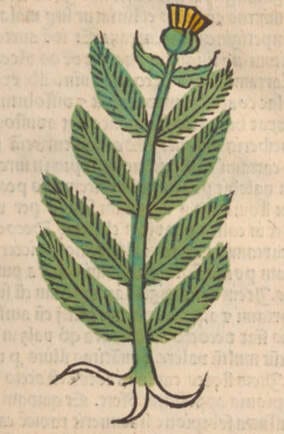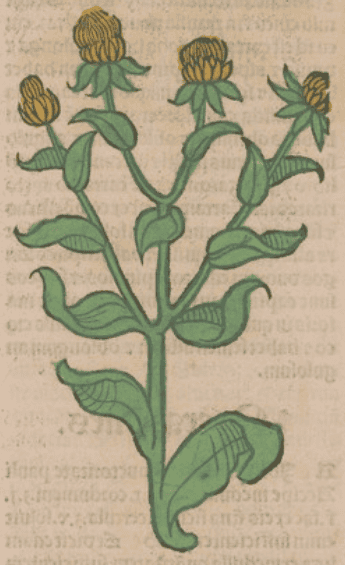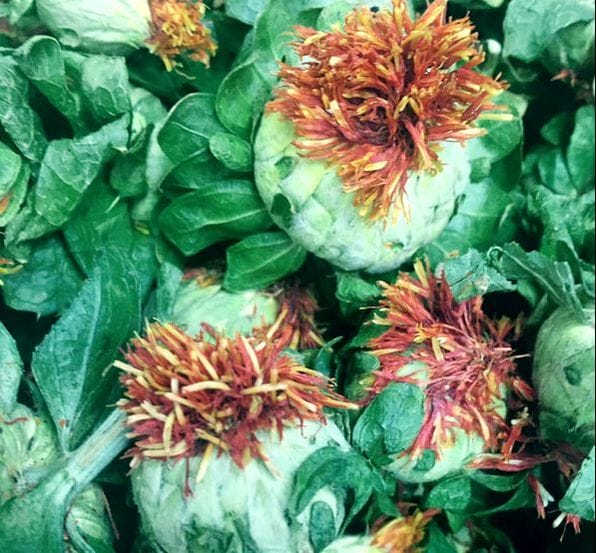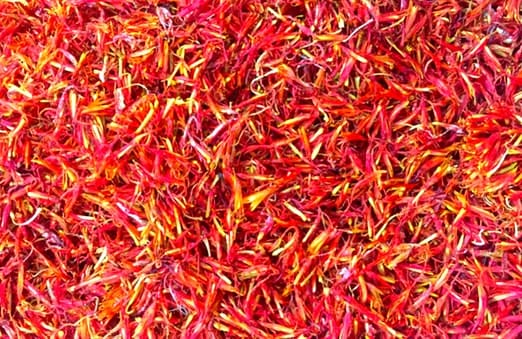Carthamus Flos, Safflower, Hong Hua 红花Bastard or Wild Saffron; Cnicus, Crocus Saracenicus, CartamusKusumbha, Vahinshikha (Ayurveda) Qurtum, Asfar (Unani) Chendurakam (Siddha) Gur Gum གུར་གུམ་ (also used for Saffron) Rtsa Gur Gum རྩ་གུར་གུམ་ (Carthamus, Tibet) Hong Hua (TCM) |

|

|
 Herbarius latinus, Petri, 1485
Herbarius latinus, Petri, 1485 |
 Ortus Sanitatis, Meydenbach, 1491
Ortus Sanitatis, Meydenbach, 1491 |

|
 Above: Safflower
Above: Safflower Left: dried whole Safflower flower (Adam, 2016, 2018) |
Botanical name:
Carthamus tinctorius
Parts used:
Flower
Seed also Safflower Seed
Temperature & Taste:
Warm, dry. Pungent
“Hot in the first and dry in the second degree” (Avicenna)
Classifications:
2D ATTENUATERS OF CONGEALED BLOOD
2L. EMOLLIENT
TCM:
K. Move the Blood
Uses:
1. Moves the Blood, Promotes Menstruation, Eases Pain:
-Amenorrhea, Dysmenorrhea with clotting or dark blood
-delayed or obstructed Menstruation
-Endometriosis, Fibroids, Uterine Tumors
2. Moves the Blood, Clears Stasis:
-Blood stasis, Trauma, Hematoma
-Chest Pain, sharp stabbing pain from Blood stasis
-‘it functions on the Heart and nourishes it’. (Ben Cao Gang Mu)
-Hardness, Tumors (movable and static), Fibroids; adjunct in Cancer
-promotes eruption of Measles, Scarlet Fever, Chickenpox, Small Pox etc. (not used once full eruption has occurred)
-smaller doses can be used for Bleeding due to excess Heat or Blood obstruction
-‘it dredges the channels’. (Li Shi Zhen)
-accepted substitute for Saffron
3. Benefits the Liver:
-One of the Six Excellent Medicines of Tibetan Medicine
-in Tibetan Medicine, Safflower (or Saffron) is the Excellent Medicine associated with the Liver. It treats all Liver disease and supports Liver function. It is regarded as a regulating tonic for the Liver.
-has been used for Jaundice, Hepatitis (Tibet)
4. Externally:
-used externally in oils and plasters for Blood Stasis, Trauma, Bruising and Pain
-“It clears Freckles and Pityriasis” (Avicenna)
-“Safflower is applied on ringworm”. (Avicenna)
Dose:
1. Small doses nourish and regulate the Blood, moderate doses move the Blood, large doses break blood accumulation and dissolve Tumors. ‘If the drug is heavily dosed, it functions to remove the blood stasis. If the dosage is small, it has the function of nourishing the blood’. (Zhu Zhen Heng)
2. It may be decocted in wine or made into a tincture to increase its blood-moving effect.
Decoction: 1–9 grams; 1–2 grams (low doses); 3–5 grams (moderate dose); 7–9 grams (large dose)
Powder: 500mg–5 grams; 500mg–1 gram (low dose); 1–2 grams (moderate dose); 3–5 grams (large dose)
Correctives:
Aniseed (Unani)
Substitutes:
1. Safflower is a substitute for Saffron. In cases with severe blood stagnation, chest pain, or the elderly with Melancholy, Saffron can be used in its place.
2. Calendula
3. Pistachia terebinthus (Unani)
4. Safflower seed has the same effect as Safflower flower (Su Song)
Preparation:
1. Wine-prepared Safflower:
Safflower can be sprinkled with wine, then gently dried or stir-fried. This increases its blood moving effect and functions better on the Blood. Taken as a tincture or decocting in wine also achieves this.
2. Ghee-prepared Safflower:
When used in rejuvenating compounds, Safflower is soaked in ghee. (Tibet)
Main Combinations:
Peach kernel / Bitter Almond kernel & Saffron / Safflower
Safflower is often combined with Peach kernel (Tao Ren) in TCM. This is similar to the combination of Saffron and Bitter Almond in the Western Tradition. Both work to open obstructions, move the Blood, and ease pain. Safflower is penetrating, but dry. Almond or Peach kernel are heavy, oily and slippery. They thereby correct each other to enhance the effect. Used for fixed, sharp pain; congealed and bruised blood; menstrual pain with dark, clotted menstruation as well as Fibroids and Tumors.
Gynecology:
1. Amenorrhea, Obstructed or painful Menstruation:
i. Safflower with Rice Wine (or other alcohol) (as in Hong Lan Hua Jiu from Jin Gui Yao Lue [Essential Prescriptions of the Golden Coffer]).
ii. Safflower with Peach kernel (or Bitter Almond), Dang Gui, Peony (Bai Shao), Rehmannia Shu Di Huang, Ligusticum Chuan Xiong (as in Tao Hong Si Wu Tang from Yi Zong Jin Jian [Golden Mirror of Orthodox medicine]),
iii. Safflower with Peach kernel (or Bitter Almond), Dang Gui, Peony (Bai Shao) and Cyperus rotundus (Xiang Fu) (TCM)
iv. Safflower, Bdellium, Myrrh, Turmeric, Rose, Cyperus rotundus
2. Postpartum abdominal pain:
i. Safflower with Dang Gui, Motherwort (Yi Mu Cao)
ii. Safflower with Cattail pollen (Pu Huang), Tree Peony root bark (Mu Dan Pi), Lotus leaf (He Ye) (as in Hong Hua San from Huo Fa Ji Yao [Essentials of Flexible Methods]).
Blood Stasis:
3. Abdominal pain from Blood stasis, Safflower with Peach kernel (Tao Ren), Ligusticum Chuan Xiong, Dang Gui, Achyranthes Niu Xi, Bitter Orange Zhi Ke. (as in Xue Fu Zhu Yu Tang)
4. Chest pain, Angina Pectoris:
i. Safflower with Salvia Dan Shen. This is also used for Myocardial Ischemia and inhibits thrombosis (TCM)
II. Safflower, Salvia Dang Shen, Borneo Camphor (Bing Pian)
iii. Safflower, Bdellium, Arjuna (Ayurveda)
iv. Safflower, Galangal, Sandalwood
v. Safflower, Myrrh, Musk
5. Internal Bruising:
i Safflower with Dang Gui, Peach kernel and Rhubarb (TCM)
ii. Safflower, Bitter Almond, Lacca, Madder (West)
iii. Safflower, Madder, Rhubarb, Myrrh
6. Post-Stroke:
i. Safflower, Astragalus Huang Qi
ii. Safflower, Ligusticum Chuan Xiong, Notoginseng San Qi, Salvia Dan Shen
Other:
7. To promote eruption in Eruptive Fevers:
i. Safflower with Mint, Long Pepper
ii. Safflower with Balm, Elder flower, Violet leaf and Licorice.
8. As a Liver tonic:
i. Safflower with Sandalwood, Clove, Costus, and Triphala (as in Safflower 13 of Tibetan Medicine)
ii. Safflower, Swertia, Emblic Myrobalan
9. To nourish and regulate the Blood, Safflower with Dang Gui
Major Formulas
Qi Li San
Shen Tong Zhu Yu Tang
Xue Fu Zhu Yu Tang
Antelope Horn 14 (Rgya ru bcu bzhi) (Tibetan)
Antidotal 18 (Gnyen po bco brgyad)
Barberry 8 Powder (Skyer sun brgyad pa) (Tibetan)
Coptis 5 Pill (Tibetan)
Joyful 16 Pill (Dg’a ba bchu drug) (Tibetan)
Minister 3 (Tibetan)
Minister 9 (Tibetan)
Raisin 7 (Tibetan)
Safflower Supreme 7 (Gur gum mchog bdun) (Tibetan)
Sandalwood 8 (Tsan dan brgyad pa) (Tibetan)
Six Excellent Medicines (Tibetan)
Undying Aloeswood 8 (Chi med a gar brgyad pa)
Cautions:
1. Not used in Pregnancy.
2. Avoid in Bleeding
3. Gastric Ulcers
Drug Interactions:
Due to its blood thinning effects it must be used very cautiously in people taking blood thinning medication such as heparin and warfarin.
Effects of safflower injection on the pharmacodynamics and pharmacokinetics of warfarin in rats.
